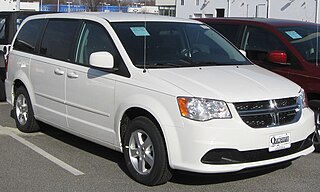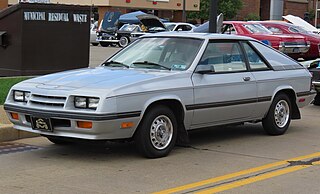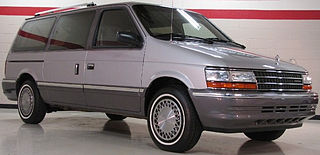
Plymouth was a brand of automobiles produced by Chrysler Corporation and its successor DaimlerChrysler. The brand was launched in 1928 to compete in what was then described as the "low-priced" market segment that was dominated by Chevrolet and Ford. It became a high-volume seller for the automaker until the late 1990s. Plymouth cars were marketed primarily in the United States. The brand was withdrawn from the marketplace in 2001. The Plymouth models that were produced up until then were either discontinued or rebranded as Chrysler or Dodge.

The Dodge Caravan is a series of minivans manufactured by Chrysler from the 1984 through 2020 model years. The Dodge version of the Chrysler minivans, was marketed as both a passenger van and a cargo van. For 1987, the model line was joined by the long-wheelbase Dodge Grand Caravan. Produced in five generations across 36 model years, the Dodge Caravan is the second longest-lived Dodge nameplate. Initially marketed as the Dodge counterpart of the Plymouth Voyager, the Caravan was later slotted between the Voyager and the Chrysler Town & Country. Following the demise of Plymouth, the model line became the lowest-price Chrysler minivan, ultimately slotted below the Chrysler Pacifica.

The Chrysler Cirrus is a mid-sized 4-door notchback sedan introduced by Chrysler motors for the 1995 model year. Built on the Chrysler JA platform, the 4-door notchback sedan joined Chrysler's roster of "Cloud Car" models drawing their names from meteorological terms, including the mid-priced Dodge Stratus it was based on introduced at the same time, and the low-priced Plymouth Breeze variant a year later.

The Dodge Daytona is an automobile which was produced by the Chrysler Corporation under their Dodge division from 1984 until 1993. It was a front-wheel drive hatchback based on the Chrysler G platform, which was derived from the Chrysler K platform. The Chrysler Laser was an upscale rebadged version of the Daytona. The Daytona was restyled for 1987, and again for 1992. It replaced the Mitsubishi Galant-based Challenger, and slotted between the Charger and the Conquest. The Daytona was replaced by the 1995 Dodge Avenger, which was built by Mitsubishi Motors. The Daytona derives its name mainly from the Dodge Charger Daytona, which itself was named after the Daytona 500 race in Daytona Beach, Florida.

The Dodge Spirit is a midsize automobile marketed by Dodge from the 1989 to the 1995 model years. The singular successor of the Dodge Aries, Dodge Lancer, and the Dodge 600, the Spirit was slotted between the Shadow and the Dynasty within the Dodge product line. In contrast to its predecessors, the Spirit was sold exclusively as a four-door notchback sedan.

The Dodge Omni and the nearly identical badge engineered variant, the Plymouth Horizon, is a subcompact car manufactured and marketed by Chrysler Corporation for model years 1978–1990. The first Chrysler model line produced with front-wheel drive, the Omni and Horizon were also the first front-wheel drive economy cars assembled in the United States. Marketed for eleven years with very few changes, around 2,500,000 Omnis and Horizons were manufactured, with the Plymouth variants more popular than the Dodge-branded models.

The Chrysler minivans are a series of minivans that have been produced and marketed by the American automaker Chrysler since the 1984 model year. Currently in its sixth generation, the model line is marketed worldwide, primarily in North America and Europe. Introduced as the Dodge Caravan and Plymouth Voyager, the Chrysler minivans have been marketed under a variety of nameplates under the Chrysler, Plymouth, Dodge, and Ram brands; through the use of rebadging, the model line has also been marketed under the Lancia and Volkswagen brands.

The 2.2 and 2.5 are a family of inline-4 engines developed by Chrysler Corporation originally for the Chrysler K- and L-platforms cars and subsequently used in many other Chrysler vehicles. After its launch in 1981, it became the basis for all Chrysler-developed 4-cylinder engines until the Chrysler 1.8, 2.0 & 2.4 engine family was released in 1994. It was the first Chrysler engineered four cylinder engine since the Chrysler flathead four cylinder was discontinued in 1933.

The Chrysler LeBaron is a line of automobiles built by Chrysler from 1931 to 1941 and from 1977 to 1995. Chrysler also used the LeBaron name for the Imperial LeBaron from 1957 to 1975.

The Dodge Colt is a subcompact car that was manufactured by Mitsubishi Motors and marketed by Dodge for model years 1971 to 1994 as captive imports. Rebadged variants include the Plymouth Champ and Plymouth Colt, both were marketed by Plymouth.

The Plymouth Laser is a two-door 2+2 sports coupe sold by Plymouth from 1989 until 1994. The Laser and its siblings, the Mitsubishi Eclipse and Eagle Talon, were the first vehicles produced under the newly formed Diamond-Star Motors, a joint-venture between the Chrysler Corporation and the Mitsubishi Motors Corporation.

Plymouth Voyager is a nameplate for a range of vans that were marketed by Plymouth from 1974 to 2000. One of the few light trucks marketed by the division, the Voyager was initially a full-size van, later becoming one of the first minivans successfully marketed in North America.

The Dodge Stratus is a mid-size car that was introduced by Dodge in December 1994 and was based on the 4-door sedan Chrysler JA platform. The Stratus, Plymouth Breeze, and Chrysler Cirrus were all on Car and Driver magazine's Ten Best list for 1996 and 1997. It received critical acclaim at launch, but ratings fell over time. An updated version of the Stratus was introduced for 2001, with the Cirrus being renamed as the Chrysler Sebring, and a coupé model was also added to the range. Production ended in early 2006 at the Sterling Heights Assembly Plant after building 1,308,123 Stratus and Sebrings since 2000.

The Dodge Aspen, and its badge engineered variant, the PlymouthVolaré, are compact rear-drive cars manufactured and marketed by Chrysler for model years 1976-1980 in four-door sedan, two-door coupe, and four-door wagon styles.

The Neon is a compact car built from November 1993 until 2005 by the American Chrysler Corporation over two generations. It has a front-engine, front-wheel-drive layout and was available in two-door and four-door sedan body styles. In the United States and Canada, it was sold as either a Dodge or a Plymouth, while in Europe, Mexico, Japan, South Korea, Egypt, Australia, South Africa, and South America, it was branded as a Chrysler.

The Plymouth Acclaim is a mid-size sedan produced in the 1989 to 1995 model years. The Acclaim was Plymouth's updated replacement for both the similarly sized E-body Caravelle and the K-body Reliant. Badge engineering was employed to give Dodge and Chrysler their own versions of the AA-body Acclaim: the Dodge Spirit, the Chrysler LeBaron sedan, and the export-market Chrysler Saratoga. It was replaced by the Plymouth Breeze in 1996.

The Dodge Charger (L-body) is a subcompact two-door hatchback/fastback built by Dodge from 1981 until 1987. It is based on Chrysler's front-wheel drive L platform. A companion model, the Plymouth Turismo, was also marketed.

The first-generation Chrysler minivans are a series of minivans produced and marketed by the Chrysler Corporation from the 1984 to the 1990 model years. Introduced as the first minivans from an American-brand manufacturer and popularizing the minivan as a vehicle, the Dodge Caravan and Plymouth Voyager were launched ahead of chief competitors Chevrolet Astro/GMC Safari and Ford Aerostar.

The second-generation Chrysler minivans are a series of minivans that were manufactured and marketed by Chrysler Corporation in North America and Europe from 1991 to 1995. Officially designated the AS platform by Chrysler, the second-generation minivans were an extensive revision of the first-generation chassis and body. As before, passenger and cargo configurations were sold by Dodge, Plymouth, and Chrysler divisions. The first minivans offered with driver-side airbags and with optional integrated child safety seats, the second-generation Chrysler minivans offered all-wheel drive as an option for the first time; a manual transmission would be offered for the last time in the North American market.

The third-generation Chrysler minivans are a series of passenger minivans that were marketed by the Chrysler Corporation from the 1996 to 2000 model years. The first ground-up redesign of the model lines since their introduction, designers added a further degree of divisional identity between the Plymouth Voyager, Dodge Caravan, and Chrysler Town & Country. In a notable change, the cargo van was discontinued, with all examples sold as passenger vans. Coinciding with the retirement of the Plymouth brand during 2001, this is the final generation marketed as the Plymouth Voyager.



























